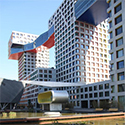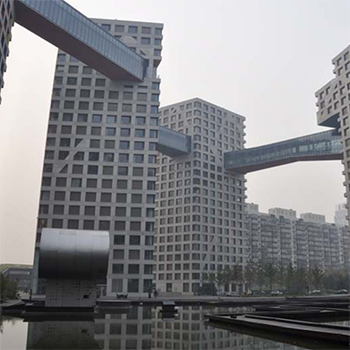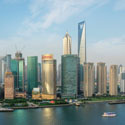Filter by
You must be a CTBUH Member to view this resource.
Linked Hybrid T9
Building
Completed, 2009
residential
LEED Certified
66.0 m / 217 ft
21
The Engineer of Record takes the balance of the engineering effort not executed by the “Design Engineer,” typically responsible for construction documents, conforming to local codes, etc.
The Design Engineer is usually involved in the front end design, typically taking the leadership role in the Schematic Design and Design Development, and then a monitoring role through the CD and CA phases.
Other Consultant refers to other organizations which provided significant consultation services for a building project (e.g. wind consultants, environmental consultants, fire and life safety consultants, etc).
These are firms that consult on the design of a building's façade. May often be referred to as "Cladding," "Envelope," "Exterior Wall," or "Curtain Wall" Consultant, however, for consistency CTBUH uses the term "Façade Consultant" exclusively.
You must be a CTBUH Member to view this resource.
Usually involved in the front end design, with a "typical" condition being that of a leadership role through either Schematic Design or Design Development, and then a monitoring role through the CD and CA phases.
Usually takes on the balance of the architectural effort not executed by the "Design Architect," typically responsible for the construction documents, conforming to local codes, etc. May often be referred to as "Executive," "Associate," or "Local" Architect, however, for consistency CTBUH uses the term "Architect of Record" exclusively.
The Design Engineer is usually involved in the front end design, typically taking the leadership role in the Schematic Design and Design Development, and then a monitoring role through the CD and CA phases.
The Engineer of Record takes the balance of the engineering effort not executed by the “Design Engineer,” typically responsible for construction documents, conforming to local codes, etc.
The Design Engineer is usually involved in the front end design, typically taking the leadership role in the Schematic Design and Design Development, and then a monitoring role through the CD and CA phases.
The main contractor is the supervisory contractor of all construction work on a project, management of sub-contractors and vendors, etc. May be referred to as "Construction Manager," however, for consistency CTBUH uses the term "Main Contractor" exclusively.
Other Consultant refers to other organizations which provided significant consultation services for a building project (e.g. wind consultants, environmental consultants, fire and life safety consultants, etc).
These are firms that consult on the design of a building's façade. May often be referred to as "Cladding," "Envelope," "Exterior Wall," or "Curtain Wall" Consultant, however, for consistency CTBUH uses the term "Façade Consultant" exclusively.
Best Tall Building Worldwide 2009 Winner
2009 CTBUH Awards
Best Tall Building Asia & Australasia 2009 Winner
2009 CTBUH Awards
CTBUH Holds Half-Day Skybridges Symposium
18 July 2019 - Event
Master's Thesis Challenge
28 August 2017 - CTBUH News

10 April 2019 | Beijing
Reconnecting the City Grid With a Porous Urban Space
The pedestrian-oriented Linked Hybrid complex, sited adjacent to the old city wall of Beijing, was among the first new-build projects to counter the predominant trend...

01 July 2018
Exploring New Paradigms in High-Density Vertical Hybrids
Swinal Samant & Srilakshmi Menon, National University of Singapore
By the year 2050, the world population is set to increase to 9 billion people, of which 66% will be living in cities. It is...
The pedestrian-oriented Linked Hybrid complex, sited adjacent to the old city wall of Beijing, aims to counter current urban developments in China by creating a new twenty-first century porous urban space, inviting and open to the public from every side. A filmic urban experience of space; around, over and through multifaceted spatial layers, as well as the many passages through the project, make the Linked Hybrid an “open city within a city”. The project promotes interactive relations and encourages encounters in the public spaces that vary from commercial, residential and educational, to recreational; a three-dimensional public urban space.
The project exists on three levels. The ground level offers a number of open passages for all people (residents and visitors) to walk through. These passages include “micro-urbanisms” of small scale shops which also activate the urban space surrounding the large central reflecting pond. All public functions on the ground level—including a restaurant, hotel, Montessori school, kindergarten, and cinema—have connections with the green spaces surrounding and penetrating the project. On the intermediate level of the lower buildings, public roof gardens offer tranquil green spaces. The central roof garden features an open design to reflect the architectural structure of the cinematheque. At the top of the eight residential towers private roof gardens are connected to the penthouses.
Elevators displace like a “jump cut” to a series of passages on a higher level. From the 18th floor a multi-functional series of skybridges with a swimming pool, a fitness room, a café, hotel bar, and an art gallery, connect the eight residential towers and the hotel tower, and offer views over the city. The shops at the grade level are complimented by the programs at the bridge level and work together to be semi-lattice-like rather than simplistically linear. The complex aims to achieve a programmatic self sufficiency of amen-ities for residents. By bringing diverse programs together both on the ground floor and in the bridges, the project stresses ambulatory circulation. Rather than skybridges that drain street life, the aim is for a base route and sky route that will constantly generate random relationships like the richness of metropolitan density; functioning as social condensers in a special experience of city life to both residents and visitors.
In proposing the sectional variety of Linked Hybrid, the aim is for new “Z” dimension urban sectors that aspire to individuation in urban living while shaping public space. In the experience of traversing the bridge route, one feels the urban excitement of the passage of the body through space. Movement, spatial sequence and time of day with different light are intertwined. The point of view changes with a slight ramp up, a slow right turn, or a stop to gaze at the distant urban view. The encircled route connects the towers in a new collective aspiration—different from towers as isolated iconic objects. The context of this new linkage is the increasingly privatized and objectified nature of recent Beijing developments.
Geo-thermal wells—660 in number—at 100 meters (328ft) deep, provide Linked Hybrid with cooling in summer and heating in winter, and make it one of the largest green residential projects in Beijing. About 70% of the heating and cooling load is covered by the geothermal system throughout the year. Using this closed-loop system saves a calculated 5600 KW in energy during summer and 3700 KW in winter.
The large urban space at the center of the project is activated by a grey water recycling pond with water lilies and natural grasses in which the cinematheque and the hotel appear to float. The pond is part of a total project grey water recycling system, which connects all apartments to a main ultraviolet filter tank system and with distribution watering all landscape gardens and roof gardens. In Beijing, where water shortage requires urgent measures, Linked Hybrid sets a new example as a total ecological urban sector with living, working, cultural, and recreational facilities operating from the same sustainable systems of water recycling and geothermal cooling and heating.
In the winter the pool freezes to become an ice-skating rink. The cinematheque is not only a gathering venue but also a visual focus to the area. The cinematheque architecture floats on its reflection in the shallow pond, with its exterior wall capable of projecting films, adding vitality to the community. Its first floor is left open to the community, with views over the landscape surrounding the building. The three film projection halls will be occupied by Broadway Cinema from Hong Kong.
The polychrome of Chinese Buddhist architecture inspires a chromatic dimension. The undersides of the bridges and cantilevered portions are colored membranes that glow with projected nightlight. Based on chance operations of the I-Ching, the window jambs and heads have colors found in ancient Chinese temples. The façades are monochrome revealing their colors in the parallax views of movement around or looking up. An exoskeletal concrete frame with insulation and sanded aluminum skin is utilized throughout with lateral earthquake bracing exposed in the gridded structural wall. This allows maximum flexibility for interior apartment layouts while establishing the space. A basic model apartment was designed with “hinged space,” in which rotating walls allow loft-like open apartments with long diagonal interior views. Spaces are connected by visual perspective, from one room to the next.
Re-using the earth excavated from the new construction, five landscaped mounds to the north contain recreational functions. The “Mound of Childhood”, integrated with the kindergarten, has an entrance portal through it. The “Mound of Adolescence” holds a basketball court, a roller blade and skate board area. In the “Mound of Middle Age” there is a coffee and tea house (open to all), a Tai Chi platform, and two tennis courts. The “Mound of Old Age” is occupied with a wine tasting bar and the “Mound of Infinity” is carved into a meditation space with circular openings referring to infinite galaxies.
At the Linked Hybrid project, the idiosyncratic changes of new users and adjustments according to taste are already visible—life at the urban scale goes on—but the hope of shaping new public space with Hybrid Buildings of “Z” dimension experiences remains a core intention. The overlapping perspective thrill of walking the skybridge route is matched by the amazing porous sense of urban enclosure while walking within the public space at grade. The magical night time up-lighting on the bridges reflected in the central pond are phenomenal experiences which cannot be photographed—they must be felt via the body in space.
Best Tall Building Worldwide 2009 Winner
2009 CTBUH Awards
Best Tall Building Asia & Australasia 2009 Winner
2009 CTBUH Awards

10 April 2019 | Beijing
Reconnecting the City Grid With a Porous Urban Space
The pedestrian-oriented Linked Hybrid complex, sited adjacent to the old city wall of Beijing, was among the first new-build projects to counter the predominant trend...

04 February 2010 | Beijing
The Re-making of Mumbai: Search for an Appropriate Skyscraper Response
In the early part of 2009, twelve students from the Illinois Institute of Technology, under the tutelage of Professor Antony Wood and working together with...

22 October 2009 | Beijing
2009 Best Tall Building Award Winners: Linked Hybrid Building, Beijing, China
Steven Holl, Steven Holl Architects presents at the CTBUH 2009 Chicago Conference. Each year the CTBUH recognizes excellence in tall building design and construction by...

22 October 2009 | Beijing
The CTBUH named the Linked Hybrid building as the 2009 Best Tall Building Overall at the 8th Annual Awards Dinner, held at Crown Hall in...

01 July 2018
Exploring New Paradigms in High-Density Vertical Hybrids
By the year 2050, the world population is set to increase to 9 billion people, of which 66% will be living in cities. It is...

12 September 2012
Big Shifts Ahead as China Enters New Era
Reports out of China these days are a jumble of mixed messages and conflicting imagery. One night network business news programs spotlight video of empty...

10 October 2011
Tall Buildings + Skybridges + Envelope + Green = Greenplex
The skyscraper/sprawl urban paradigm of the 20th century is deemed unsustainable because it is characterized by: excessive exposed surface area that wastes heating/cooling energy, limited...
18 July 2019
More than 100 attendees gathered at Linked Hybrid for a symposium held in conjunction with the forthcoming skybridge research project, “Bringing the Horizontal Into the Vertical Realm.”
28 August 2017
CTBUH is launching a new academic initiative, empowering Master's-level architecture students to research new possibilities in rope-less elevator technology.
15 July 2013
Working well above the plane of purely sculptural architecture, the project embodies, on an urbanistic scale, where the future of tall buildings and urban cities is heading.
Subscribe below to receive periodic updates from CTBUH on the latest Tall Building and Urban news and CTBUH initiatives, including our monthly newsletter. Fields with a red asterisk (*) next to them are required.
View our privacy policy